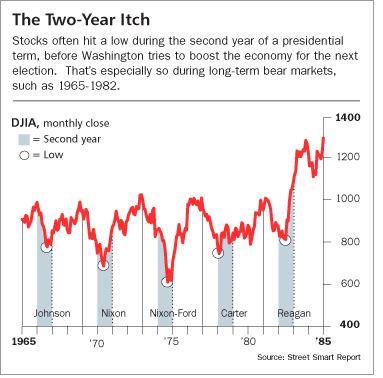This weeks Barron’s has an interesting chart from Sy Harding. If you are unfamiliar with Harding’s work, have a look at his prescient 1999 book, “Riding the Bear: How to Prosper in the Coming Bear Market.” (Spend the $1.49 on used copy — its well worth it).
Harding suggests that:
“UNLESS I’M LOOKING AT the wrong calendar, stocks are headed for a rough patch next year. That’s because 2006 is the second year of a presidential term, and the market historically hits a significant low in those years.
The trend has been strongest in long-term, or secular, bear markets,
such as the period of 1965 through 1982. But the pattern has been clear through bull and bear periods alike — and through war and peace, rising and falling interest rates, high and low inflation — regardless of which party was in power.”
That’s consistent with our prior discussions of the Presidential Market Cycle (See this: Mid-term Presidential Election cycle, and this: 4 Year Cycle).
In the past, I wondered if the 2nd year low held up for two term Presidents. Harding assures us it does: ” This has been true even for second-term presidents like George Bush. After all, they want their party to remain in power.”
I found the numerical equivalent of this some years ago, and posted it in the Mid-term Presidential Election cycle:

This is consistent with my prior expectation that my most likely scenario, where the markets top out in December, and then head south in ’06.
Source:
It’s the Cycle, Stupid!
SY HARDING
Barron’s, Saturday, September 10, 2005
http://online.barrons.com/article/SB112631643546337049.html



Barry,
And head south they will, by the end of 06 you could see a 30 – 40% drop. DJIA target is 6500 – 7500.
The Nattering One
Thanks for pointing to the book.
I have not looked into the DJIA. However, the longest period between average annual highs for the S&P 500 since 1950 was 8 years. (check me on this http://tinyurl.com/97bhe).
It is impossible to hold all things constant, and the past does not predict the future. However, if past patterns are any guide, then the S&P 500 highs from 2000 would be reached around year 2008. One might make a decent argument for a little sooner (year 2007). One could argue later than 2008 due to shocks to economy, big interest rates increases and reversal of trend of decreasing nominal interest rates since 1970s, bad weather, terrorism, war, unexpected inflation or deflation, other random events, arguably overextended U.S. And just because an index reaches a new high does not mean the real return (adj for inflation) or risk-adjusted return is attractive.
When people curtail investing in housing and residences, where will the investment go? This might give a boost to stocks (although it might not).
In the near future, the stock market might do okay even if GDP slows down and misery-type indexes increase.
It might help to look at indexes other than the DJIA. You probably need a mix of small, large and mid-cap. How does the DJIA relate to total market cap today vs. 1970s?
Just ordered the book, Barry.
Thanks for the heads up — keep ’em coming.
As long as were on books, I just re-read Mark Cuban’s favorite book on stocks — “The Number”
And now I’m reading Morningstar’s “Guide to Successful Stock Investing.”
I’m getting a kick out of the DCF analysis.
Have a good weekend, buddy.
http://www.bestbookbuys.com is a great price search engine for used books.
Even cheaper is checking your local library’s on-line catalog first to see if they already have it. ;-)